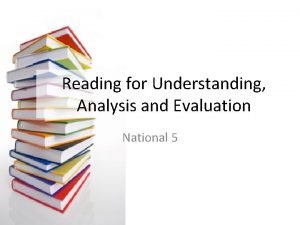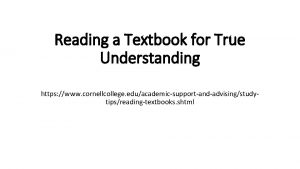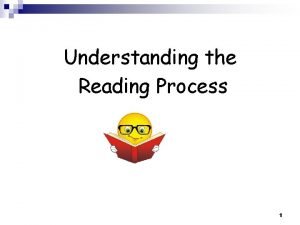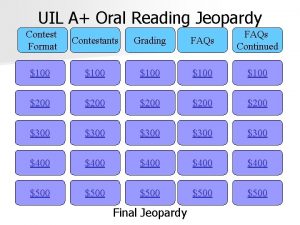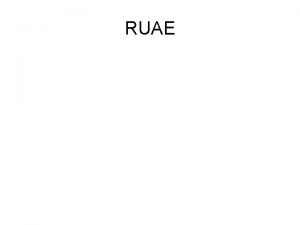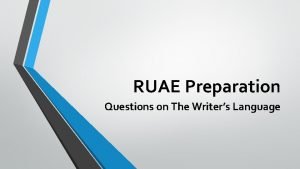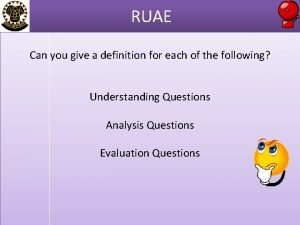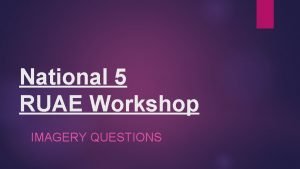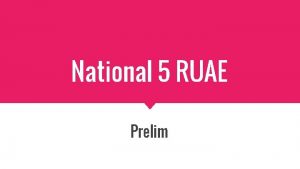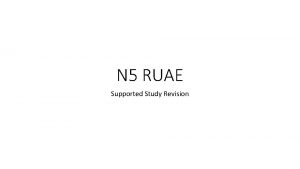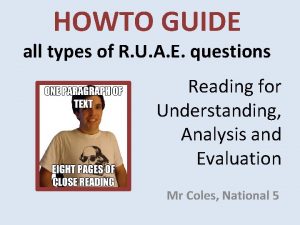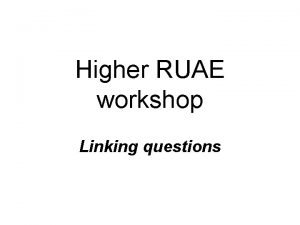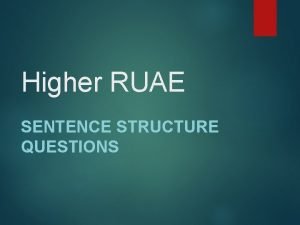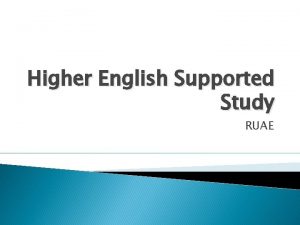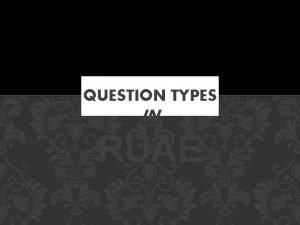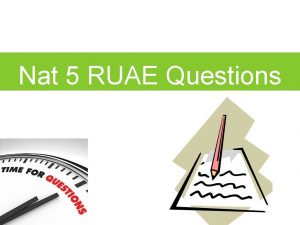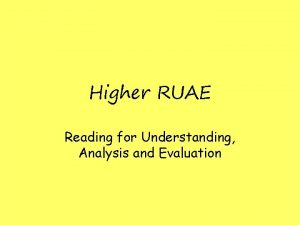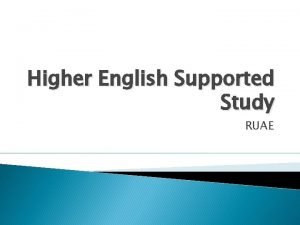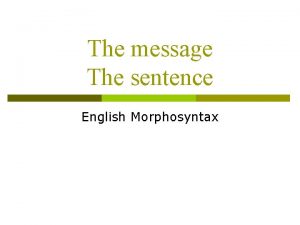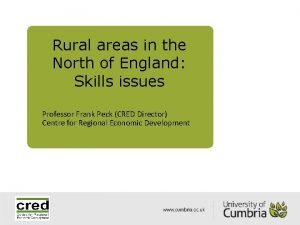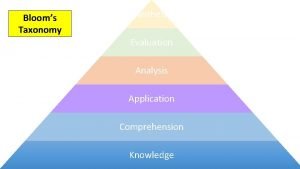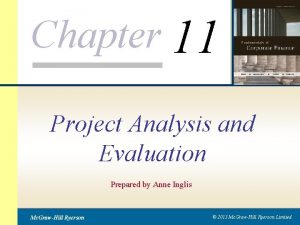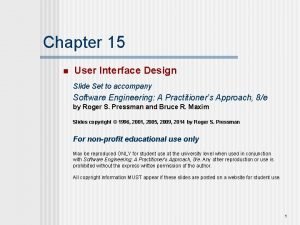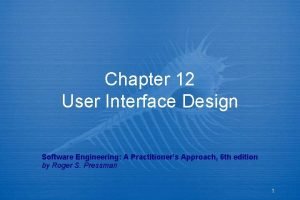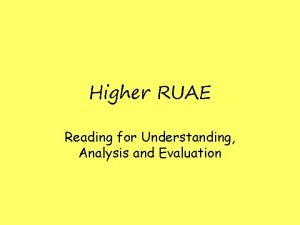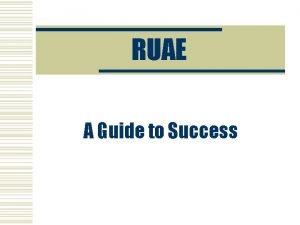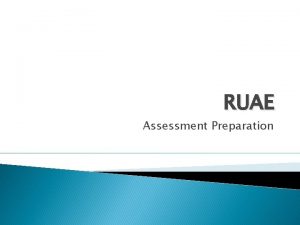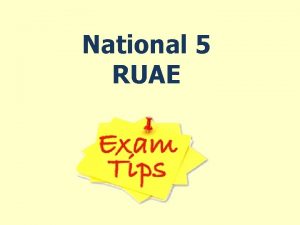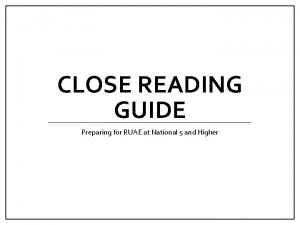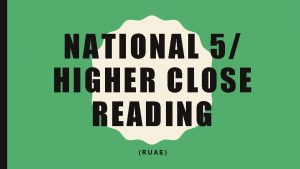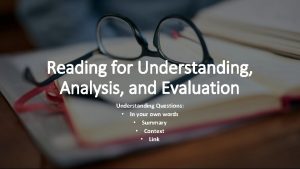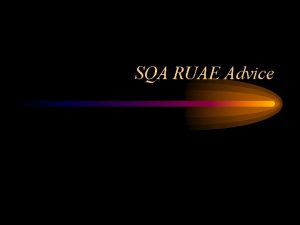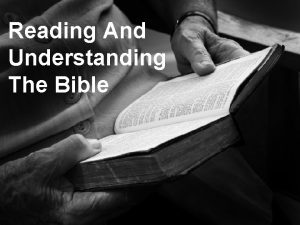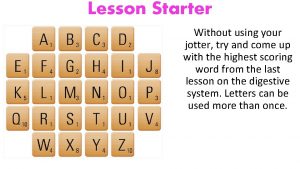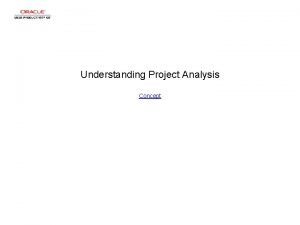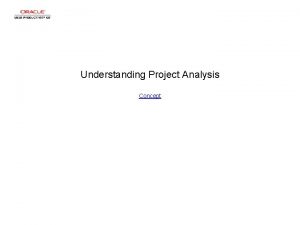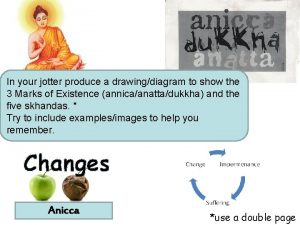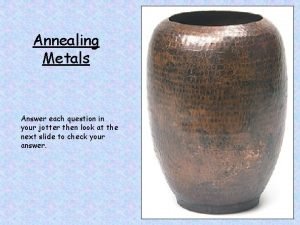Reading for Understanding Analysis and Evaluation RUAE Jotter












































































































- Slides: 108

Reading for Understanding, Analysis and Evaluation RUAE Jotter National 5

Reading for UAE Skills How we are going to achieve…

RUAE questions focus on three aspects. . . 1) Understanding 2) Analysis 3) Evaluation • • • What the writer is saying (Understanding) How the writer is saying it (Analysis) How effectively he is saying it (Evaluation) Revising RUAE at home: Once you have the strategies you are able to practise them at home. You can complete past papers from the SQA website, although I would hold off until later. Best revision is reading Opinion, Comment or Voice articles from news websites – aim for one a week. Scotsman The Herald The Times The Guardian The Telegraph Basic news articles do not express much opinion or contain many rhetorical devices.

Section A - Understanding Questions 1. 2. 3. 4. 5. In your own words questions Summary question Linking questions Context questions Contrast questions

In your own words questions. CONTENTS

In your own words Question - Formula There are two jobs to do for in your own words questions: 1) Find the correct answer in the passage – LOCATE 2) Turn it into your own words – TRANSLATE Remember: LOCATE and TRANSLATE

Own words Worked Example Passage NO NOVEL OF THE PAST CENTURYhas had more influence than George Orwell’s 1984. The title, the adjectival form of the author’s last name, the vocabulary of the all-powerful Party that rules the superstate Oceania with the ideology of Ingsoc doublethink, memoryhole, unperson, thoughtcrime, Newspeak, Thought Police, Room 101, Big Brother—they’ve all entered the English language as instantly recognizable signs of a nightmare future. It’s almost impossible to talk about propaganda, surveillance, authoritarian politics, or perversions of truth without dropping a reference to 1984. Question Using your own words, identify the reasons the writer believes 1984 has had more influence than any other book in the past century. (3)

Worked Example Bad Answer • The title • the adjectival form of the author’s last name, • the vocabulary of the book THIS IS A BAD ANSWER AS THEY HAVE QUOTED FROM THE PASSAGE Good Answer The reason the writer thinks the book is influential is because. : • The name of the book is very recognisable • The word ‘Orwellian’ is used as an adjective • The language used in the book is part of daily speech

Practice Example 1 Many of the commentators I hear on television expressing their opinions about football games leave me cold. I cannot be bothered with their ill-informed, pompous and often irrelevant contributions. I usually watch the games with the sound turned down. Explain two reasons why the writer does not like football commentators. (2)

Practice Example 2 The most worrying thing about Big Brother is it has turned the boredom of others into entertainment. It worries me that there seems to be a demand for 24 hour coverage from “The House” and there is constant footage of incredibly dull activities like housemates sleeping, cooking or sitting on their own staring into space. What sort of nation have we become when we are prepared to give up our own time to watch others who are even more bored than we are? Using your own words, explain why the writer finds Big Brother “worrying”? (2)

Practice Example 3 Scottish football went from a high – Aberdeen winning a European trophy and the national team qualifying for five World Cup Finals in a row – to a definite low. The reasons for the deterioration in the nation’s standing in the footballing world? Chronic lack of investment in youth football was one factor. The other is more profound – our unhealthy diet and obsession with alcohol started to catch up with us as a nation, particularly in terms of the athleticism (or lack of it) in our professional footballers. In your own words, describe the reasons for Scotland’s decline as a footballing nation. (3)

Summary Question CONTENTS

Summary Question • One key skill the examiners want you to have is the ability to follow, and summarise, a key idea or line of thought running throughout an article or passage. • You can expect that the final question in the exam paper will test your ability to do this.

How to answer • You must use your own words. • You get no marks for quoting. • You should use bullet points instead of writing in paragraphs. • Think: each bullet point is worth one mark.

Worked Example A crisis in the teaching profession means that the government is investing in a massive advertising campaign to attract young graduates in to the profession. “Many staff are simply at retirement age with not enough trainees to take their place, said Kathy Field, a spokesperson for the EIS, Scotland’s largest teaching union, ” however graduates are choosing other career paths with higher wages that are perceived as being of a higher status. Some teacher have also come to the conclusion that the hectic pace of modern education plus the challenge of unruly pupils, means they are leaving the profession for other, easier alternatives. ” Summarise why there a shortage of teachers in Scotland (3 marks)

Linking questions CONTENTS

Linking questions • A linking sentence is one which links two paragraphs together. • Usually this sentence will appear at the start of the second of the two paragraphs which are being linked. • Look carefully at the sentence which is the link. • There will be two parts to this sentence: • One part will link back to the content of the paragraph before. • The other part of the sentence will link forward to the content of the new paragraph.

Link Question formula 1. Quote a word or phrase that links back to earlier in the passage. 2. Quote a word or phrase that link forward to what is to come in the passage. Remember!!! You will get no marks if you quote the full link sentence!

Worked Example…. • For example, a link question based on the news article about a teenage computer curfew might be worded like this: How does the sentence ‘Needless to say, my efforts to explain this to my daughter were pretty hapless. ’ form a link between paragraphs 8 and 9?

• ‘Especially for girls, with their intimate, gossipy, social the drive to remain as connected as possible with friends is overwhelming. Yet perversely, floating in an electronic sea has the deeper effect of depriving them of the habit of being alone, developing their own thoughts. • Needless to say, my efforts to explain this to my daughter were pretty hapless. I dredged up the example of the hostage Terry Waite who got through years chained to a radiator in Beirut by the sheer strength of his interior life. My daughter listened politely, but her expression was incredulous. When was she ever going to be chained to a radiator in Beirut? ’

A good answer to this question would be: • 1) The expression ‘to explain this’ links back to the previous paragraph which discusses the harmful effects of always being connected to your phone • 2) The expression ‘my efforts were hapless’ links forward to the writer’s attempt to explain the value of having an interior life and being an individual to her daughter.

Link Example Show the underlined sentence acts as a link at this point in the passage (2) Her mother left her at the age of five. As a result, she was forced to fend for and pay for herself: ensuring she had enough to eat; clothes to wear and shelter from the elements. Despite her harsh childhood, Emma’s ancestry linked her to wealth and social standing. Her grandmother was Lady of the local clan, with a grand manse and estate to her family name, which was renowned throughout the country.

Context Questions

Context Questions You might be asked to show HOW the context helps us to understand the meaning of a word. This will usually be a two mark question: 1 for the meaning, 1 for how the context helped you find the meaning.

Context Question Formula • The word/ expression ‘_______’ as used here means ________. • I can work this from the context because __________________________.

Context question practice At Guy’s and St Thomas’ hospitals in London, an initiative was set up two years ago to help people aged 18 -30 with autism gain work experience. Staynton Brown, associated director of equality and diversity at the hospital, dismissed any suggestion of the initiative being a philanthropic one. ‘This is not a charitable gesture’, he said. ‘we want to make sure we have the most talented workforce possible. It’s in our interests in multiple ways. We’ve all benefited from the changes we’ve incorporated to accommodate those with autism. By clarifying the way we give information to and help introduce the interns into the hospital, we’ve made communication clearer for everyone, which leads to better patient care.

Context questions How does the context of the second paragraph help you to work out what is meant by ‘philanthropic’? (2)

a) • The word ‘philanthropic’ as used here means done out of feelings of charity or solely for the good of others. • I can work this out from the context because the expression is followed with the idea that employing people with autism is not ‘charitable. ’

Contrast questions CONTENTS

Contrast • Contrast is a technique often used by writers to differentiate between two aspects of an argument, or two views of an issue. • It works by setting two things against each other and asking the reader to see what the differences are. • Its effect is often to clarify a line of thought. Formula • “x” suggests. . . • This contrasts with. . . “y” as it suggests. . .

Example 1 • ‘The supreme athlete and unique showman once deemed by Time magazine to be the most instantly recognised human being in the world, struggled up from a settee, tottered across the carpet and embraced me in an enveloping bear-hug. Facially bloated he could speak only in brief, almost unintelligible gasps. ’ • By referring to these lines, show the writer uses contrast to convey his shock at meeting Muhammed Ali years later. (2)

Steps to consider • The easiest contrast to use here is probably between ‘supreme athlete’ and any of the words which suggest that physically Ali was weak: ‘struggled’, ‘tottered’. • Alternatively, you could take ‘unique showman’ and contrast that with his inability now to communicate or perform well: ‘brief almost unintelligible gasps’. • A third possibility would be to take ‘the most instantly recognised’ and contrast that with ‘facially bloated’.

Answer • The writer conveys his shock by contrasting Ali’s past physical glory, the description ‘supreme athlete’ suggesting that every muscle is honed and ready for combat, with the very weak condition he is in now. ‘Struggled’ and ‘tottered’ suggest that his muscles will hardly hold him, that he is a ruin of a man compared with what he once was.

Example Question • In days of old Bond was expected to save the world and get the girl every time. When old smoothy, Sean Connery played 007, he seduced women as frequently as he knocked back a dry martini or shot a baddie-and with equally little thought. Bond girls of old were accessories, serving only to highlight Bond’s macho aggressiveness and control. Now the new girls match our hero shot for shot. They lure Bond into the boudoir, they rescue him in the nick of time from a speeding bullet and, shock horror- sometimes they even do it better! • Explain the difference between old Bond movies and more recent films (2)

Section B - Analysis Questions (WIST) • Word Choice • Imagery • Structure • Tone

Word Choice All words that a writer uses are chosen in some way, but when we talk about word choice as a technique, we mean that certain words are deliberately chosen to obtain particular effects or to suggest particular meanings. (Not every word is word choice) Most words have two levels of meaning, a denotation and a more complex connotation. Denotation – basic, simple, straightforward meaning. Connotation – the ideas that a word suggests to you.

Word Choice: Connotations Write down some synonyms for ‘thin’. Beside each one identify a couple of connotations. e. g. Slender – connotations of healthy and graceful These words all essentially mean ‘thin’, but have massively different connotations. Scrawny – connotations of underfed and sickly-looking Slender – connotations of healthy and graceful lean - connotations of healthy and trim Slim – neutral word, also positive like thin Skinny – connotations of being unhealthy Underweight – connotations of being insufficient

Word Choice: Connotations Some words are flat and neutral: they don’t have connotations. Betsy walked into the room. What would the effect on this sentence be if ‘walked’ was changed to – slouched strode crept skipped Waddled ‘The word slouched has connotations of laziness, carelessness, and untidiness. ’

Word Choice: Connotations Some words are flat and neutral: they don’t have connotations. Betsy walked into the room. What would the effect on this sentence be if ‘walked’ was changed to – slouched Strode – confident, arrogant Crept – duplicitous, sneaky Skipped – joyful, ecstatic Waddled – timid, uncomfortable, clumsy ‘The word slouched has connotations of laziness, carelessness, and untidiness. ’

Task One: Read the statements and identify the denotation and connotation of the words underlined. The boy was interrogated about his actions by his parents. We have been bombarded with numerous images. Many claimants have had their welfare payments axed.

The boy was interrogated about his actions by his parents. D: ask questions of (someone) closely, aggressively, or formally. C: asked persistently and in hostile manner We have been bombarded with numerous images. D: attack (a place or person) continuously with bombs/subject (someone) to a continuous flow of questions, criticisms, or information. C: multiple things have been sent, continuously busy Many claimants have had their welfare payments axed. D: end, cancel, or dismiss suddenly and ruthlessly. C: Done unfairly, insensitive, without consideration

Word Choice Formula If you’re talking about word choice, you need to be able to select a word (or short phrase) and then explain why it’s important. ‘word’ + …has connotations of…. + This suggests… explanation of its connotations in your own words and link back to the question.

Example 1 The missing part of the Cinderella story is what happens when she puts on the glass slipper and disappears into the palace. Rowling filled in the blanks, describing to Jeremy Paxman how she has to cope with begging letters, journalists rifling through her bins, photographers lurking on the beach, and strangers accosting her in the supermarket. Explain how the writer’s word choice in these lines helps to show the negative effects of fame. (4 marks) The writers word choice of ‘______’ has connotations of ____, _____. This suggests __________. . .

Answer Candidates should explain how the word choice shows the negative effects of fame. Any two of the following explanations with accurate analysis for two marks each. • “begging letters” – implies unpleasant/unwanted attention • Journalists “rifling” through her bins – suggests invasion of privacy/indiscriminate searching and/or unpleasant/unwanted attention • Photographers “lurking” on the beach – implies covert/hidden/suspicion/being observed from a distance and/or unpleasant/unwanted attention

Answer • “Strangers” implies people she does not know giving her unwanted attention • “Accosted” implies unwanted attention/a sense of danger • “In the supermarket” implies she cannot perform everyday tasks

Example 2 Look at lines 25 -29. Explain how the writer uses word choice to emphasise how special the event is for teenagers attending. 4

Extract By 6 pm, several 16 -year-olds are standing in the magisterial surroundings of the Pavilion Suite at Orsett Hall. The unceasing rain hasn’t dampened the excitement as the teenagers flood in to inspect the formally laid tables, helium balloons and glittery fairy lights. The prevailing smell is of hairspray and scent. Friends who normally wear shapeless uniforms and dirty trainers are transformed into exotic peacocks in hugeskirted ball gowns, teetering heels and heavy make up.

Back to the question Look at lines 25 -29. Explain how the writer uses word choice to emphasise how special the event is for teenagers attending. 4

Answer Candidates should explain how the word choice conveys that the setting of the event and the appearance of the teenagers are different form usual. At least 2 examples with comments for full marks. �‘magisterial’ – connotations of something impressive, luxurious, dignified �‘formally’ – implies a special occasion where everything is done carefully/properly �‘transformed’ – suggests a complete change into something almost recognisable

Answer • ‘exotic peacocks’ - ‘peacocks’ has connotations of trying to show off, an elaborate, colourful appearance etc. ‘exotic’ suggests something rare, out of the ordinary • ‘shapeless uniforms’ – suggest something dull, unattractive, unappealing – contrasts with what they wear to the prom • ‘dirty trainers’ – again, unglamorous, everyday, unappealing – contrasts with ‘teetering heels’ etc.

Example 3 The following extract is taken from a passage which considers the impact of texting on our language. Show any two examples of the writer’s word choice in lines 18 -23 make clear his belief that the critics of texting are wrong. 4

Extract Research has made it clear that the early media hysteria about the novelty (and thus the dangers) of text messaging was misplaced. People seem to have swallowed whole the stories that youngsters use nothing but abbreviations when they text, such as the reports that a teenager had written an essay so full of textspeak that the teacher was unable to understand it. An extract was posted online, and quoted incessantly, but, as no one was ever able to track down the entire essay, it was probably a hoax.

Back to the question Show any two examples of the writer’s word choice in lines 18 -23 make clear his belief that the critics of texting are wrong. 4

Answer One mark for selection of word and one mark for comment. Any two of the following: • “hysteria” – suggests critics are in a panic, raising irrational objections, overreacting etc. • “swallowed whole” – suggests critics gullibility etc. • “stories”/”reports” – suggests critics are prepared to believe unfounded accounts • “incessantly” – suggests critics are obsessive, relentless, won’t stop to consider other arguments • “hoax” – suggests critics are prepared to believe something made up.

Imagery Questions • Writers use images to strengthen what they say by putting all sorts of pictures in the reader’s mind. • Imagery is not the same thing as description. A description tells us what something is like. • An imagery question will cover: • Simile • Metaphor or • Personification

IMAGERY A SIMILE tells you that one thing is like another; it compares two different objects using the words ‘like’ or ‘as’. He was as hard as a brick A METAPHOR tells you that one thing is something else. The back line was a wall. The team parked the bus during the game. PERSONIFICATION is a figure of speech where human qualities are given to animals, objects or ideas The tree danced in the wind. The stairs groaned under the passing feet

Imagery 1. The inside of the old man’s head was like a dusty old attic full of bric-abrac. 2. My alarm clock yells at me every morning. 3. My heart leapt like a salmon throwing itself up a waterfall. 4. As the band began to play, the sound erupted around the hall. 5. The young boy snaked along the corridor. 6. The pain in my stomach was like a hundred rats gnawing at my guts. 7. Rita heard the last piece of pie calling her name. 8. The stairs groaned as we walked on them.

1. The inside of the old man’s head was like a dusty old attic full of bric-a-brac. Simile 2. My alarm clock yells at me every morning. Personification 3. My heart leapt like a salmon throwing itself up a waterfall. Simile 4. As the band began to play, the sound erupted around the hall. Personification 5. The young boy snaked along the corridor. Metaphor 6. The pain in my stomach was like a hundred rats gnawing at my guts. Simile 7. Rita heard the last piece of pie calling her name. Personification 8. The stairs groaned as we walked on them. Personification

When you answer you should use the formula below: • There is a method for analysing images. • You begin with what the image literally is like, or literally means. Then you go on to the metaphorical meaning, showing how that image applies to and adds meaning to the subject under discussion. • 1) Explain the comparison / identify technique • 2) Just as. . . (explain the literal meaning), So too. . . (explain the metaphorical meaning). • 3) Link to task (This suggests…)

For Example… • 1) The writer uses a metaphor to compare his work load to a mountain. • 2) Just as a mountain is large and is challenging to climb, so too is the amount of work he has to do. 3) This suggests that the man’s workload is enormous and will be really difficult to complete.

Worked Example…. ‘Jonathan Young has big plans for his career. The business analyst at Goldman Sachs is on the autistic spectrum. But this, he says, is not something he allows to hold him back. ‘I’m the company’s global go-to guy for all the information used in every single one of our presentations; he says. ‘I’m moving up the ladder every year in terms of responsibility or promotion. My ambition is to maintain this momentum. In 10 years, I want to be someone fairly big. ’ Here’s an imagery question about this extract: 1. Comment on the imagery used here in the second paragraph. (2)

Full Answer • ‘Jonathan Young compares his progress at work to climbing a ladder. Just as climbing a ladder takes you higher, so Young is moving up and being promoted within the company. This suggests that Young is making significant progress in his career. ’ • A state the comparison: ‘Jonathan Young compares his progress at work to climbing a ladder. ’ • B analyse the image: ‘Just as climbing a ladder takes you higher, so too Young is moving up and being promoted within the company. • C say what the image shows: This suggests that Young is making significant progress in his career. ’

Sentence Structure Formula Sentence structure is how a sentence is made and built up and how the various elements are arranged. • Identify the sentence structure feature and quote • Explain its effect on the reader – link back to task

Step One: • Look out for the types of sentence the writer uses. • Here are the main types and the effect each type is likely to have:

1) Statements — tell you something. • They end in a full stop. • Most sentences are statements, so it is usually if other types of sentence are used that you will need to comment. • Writing which is made up of statements alone may have a calm or impersonal tone.

2) Questions — ask something. • They always end with a question mark. • Using questions may challenge the reader, or show uncertainty in the writer. • Look out for rhetorical questions, which do not expect an answer. They create what is called an emotive tone, which simply means one which stirs up feelings or emotions.

3) Commands — tell you to do something. • ‘Think of a number’. They end with either a full stop or an exclamation mark. • They are often used in advertisements or where the writer tries to create the effect of talking directly to the reader

4) Exclamations — express excitement or surprise. • Exclamations do not always contain verbs. They often begin with ‘What’ or ‘How’, and end in either an exclamation mark or a full stop. • Exclamations may also create an emotive or dramatic tone.

5) Minor Sentences — don’t contain a verb. Since they are abbreviations of other types of sentence they may end in a full stop or a question mark. • ‘What now? ’ ‘Oh no. ’ Such sentences will be very short and may create a tense or dramatic mood. • They are typical of informal language and may be used in direct speech, notes or diary entries.

Sentence Types 1. 2. 3. 4. 5. 6. 7. 8. Are we doing enough to combat the benefit crisis? Stop what you are doing Mark! I couldn’t believe what she had told me! Is there anything more we could be doing to help? What a place. Over 30% of people agreed with the politician’s views. If we do not act now we will forever regret it. Goodness gracious, I can’t believe it!

Sentence Types 1. 2. 3. 4. 5. 6. 7. 8. Are we doing enough to combat the benefit crisis? Question Stop what you are doing Mark! Command I couldn’t believe what she had told me! Exclamation Is there anything more we could be doing to help? Question What a place. Minor sentence Over 30% of people agreed with the politician’s views. Statement If we do not act now we will forever regret it. Command Goodness gracious, I can’t believe it! Exclamation

You will never be asked to identify types of sentence, you will always be asked to explain the effect of choosing particular sentence types. This is only possible when you know the full context.

Step Two - length: • Consider whether sentences are long and complex or short and simple.

Long/ Complex Sentences • Long sentences containing several verbs and therefore several clauses are called complex. These are typical of written English, and usually, the more complex the sentences, the more formal the language. • e. g. , It/s merely to suspect that physicians marry quality with quantity when they judge how far to intervene.

Simple Sentences • Sentences with only one verb are called simple. These are typical of speech and types of language which aim to communicate very quickly and directly. • Usually, short sentences are dramatic, have an impact on the reader, make a point in a simple or direct – or even brutal – way.

Long Vs Short Sentences 1. We looked out over the battlefield. This was it. Comment on the use of sentence structure in this part of the message. (2) 2. Be careful. That is all I have to say. Comment on the use of sentence structure in this part of the text. (2)

Long Vs Short Sentences 1. We looked out over the battlefield. This was it. Comment on the use of sentence structure in this part of the message. (2) The use of the short sentence emphasises the place the people are at is important – even deadly, as it is a battlefield. 2. Be careful. That is all I have to say. Comment on the use of sentence structure in this part of the text. (2) The use of the declarative sentence emphasises the person’s command to ‘be careful’ as it states this is all they want to say.

Share with your partner something you read over the summer holiday. • It doesn’t have to be books, as I know this is rather rare (prove me wrong).

Step Three: • Look at the arrangement of words within the sentence, particularly in longer ones. • Some of the following features may be worth commenting on. • A) Word Order • B) Particular Patterns in Sentences • C) Parenthesis • D) First or Third person • E) Punctuation

A) Word Order • The best advice is that anything unusual probably deserves a comment. • A reversal of the normal word order is known as inversion, • e. g. , ‘back we went’ instead of ‘we went back’. Using inversion throws emphasis on to a particular part of the sentence — in this example it is the word ‘back’ which is stressed. • The boy hit the ball into the garden. • The ball was hit by the boy into the garden. • The garden was where the boy hit the ball. What difference does the word order make?

Word Order - Examples 1. Gold was all I could see around me in the cave. Comment on the use of sentence structure in this part of the message. (2)

Word Order - Examples 1. Gold was all I could see around me in the cave. Comment on the use of sentence structure in this part of the sentence. (2) Using inversion, the writer places emphasis on the word ‘gold’ to show it was the most prominent item the person could see.

B) Particular Patterns in Sentences Two patterns are specially common: • list • repetition • Julius Caesar’s legendary saying ‘I came, I saw, I conquered’ is an example of both of these techniques at once. • The list of verbs ‘came, saw and conquered’ creates a sense of action. • The repetition of the personal pronoun ‘I’ suggests a speaker who is egotistical and dominating.

Comment on Sentence Structure 1) Before we go on holiday, I have to pack the cases, take the dog to the kennels, make up a packed lunch for travelling, check we have our tickets and phone for a taxi to the airport. 2) We face many problems – war, poverty, starvation, and drugs – in the world today. 3) I was filled with hate, hate such as I’d never felt before, hate I never knew I could feel. 4) I will never understand what you did. Never. 5) In all my days working with him, I have never seen him be rude to another worker or take advantage of someone’s kindness because he is always helpful and goes out of his way to be understanding if anyone is in trouble. 6) Crowds of people was all I could see around me in the busy town centre.

Example Vanity Fair (a monthly print owned by Conde Naste) has long been associated with the more liberal side of American politics. With writer and journalist Christopher Hitches as a regular guest editor, the magazine stirred controversy within the tea party alliance, bible-belters and the gentler Republicans. The magazine loves controversy. Their features on waterboarding; Guantanamo Bay; political commentary; scathing criticisms of governmental policy and of all things, the latest fashions, often offered very mixed views and opinions. This ensures that it is never a dull read. What features of sentence structure can you identify?

Example Vanity Fair (a monthly print owned by Conde Naste) has long been associated with the more liberal side of American politics. With writer and journalist Christopher Hitches as a regular guest editor, the magazine stirred controversy within the tea party alliance, bible-belters and the gentler Republicans. The magazine loves controversy. Their features on waterboarding; Guantanamo Bay; political commentary; scathing criticisms of governmental policy and of all things, the latest fashions, often offered very mixed views and opinions. This ensures that it is never a dull read. What features of sentence structure can you identify?

Your apartment is an electronic orchestra and you are the conductor. With simple flicks of the wrist and spoken instructions, you can control temperature, humidity, ambient music and lighting. You are able to skim through the day’s news on translucent screens while a freshly cleaned suit is retrieved from your automated closet. You head to the kitchen for breakfast and the translucent news display follows, as a projected hologram hovering just in front of you. You grab a mug of coffee and a fresh pastry, cooked to perfection in your humidity – controlled oven, and skim new emails on a holographic tablet projected in front of you. Your central computer system suggests a list of chores your housekeeping robots should tackle today, all of which you approve. 1. How does the sentence structure of this paragraph contribute to a conversational tone throughout? 2. Show the sentence structure suggests that technology will make future life straightforward?

Examples 1. How does the sentence structure of this paragraph contribute to a conversational tone throughout? The writers repeatedly uses ‘you’ or ‘your’ at the start of the sentence. This creates the impression that they are talking directly to the reader. 2. Show the structure of the second sentence suggests that technology will make future life straightforward? The writer lists a number of things we will be able to control: ‘temperature, humidity, ambient music and lighting’. This suggests that everything in life will be easily controlled, and that life will be therefore straightforward.

Tone refers to the attitude that a writer conveys towards a subject. When you hear someone speaking, you can tell if he/she is angry, confused, sad, excited. These tones are created by factors such as volume, the speed of speech, which words the speaker puts emphasis on and how fluently or hesitantly the words come out. We can identify tone in written English through word choice, imagery, sentence structure and other literary techniques.

Angry Tone Word Bank

How to identify the tone • Word Choice – Positive or negative connotations • Imagery - comparisons • Contrast • Punctuation – exclamation marks, question marks • Short sentences • Long sentences • Repetition • Exaggeration (hyperbole)

Tone Formula 1. Identify the tone (If it hasn’t been done for you) 2. Identify words/ a technique used to create the tone and quote it. 3. Explain how the technique you have quoted creates the tone and how it links back to the question.

Tone – Practice Questions Copy out the following sentences into your jotter. Identify the tone conveyed in each sentence and explain how the writer helps you to understand tone. 1. 2. 3. 4. ‘That boy is like a nightmare, ’ sighed Mr Smith. ‘Is that supposed to look nice? ’ he sneered. ‘Rachel! You’re an angel!’ her mother beamed. ‘I. . . . I don’t want to go into that house, ’ he stuttered.

Use of Language Questions (WIST) • Word Choice • Imagery • Structure • Tone

Use of Language Example

Revision - Formulas • IYOW/ Summarising – Use bullet points depending on marks/ Locate and Translate • Context Questions – Explain the meaning and show you got it from the context. • Link Questions – Quote, Link back, Quote, link forward. • Word Choice Questions – Identify the word, explain connotations and refer back to question. • Imagery – Explain the comparison, give literal meaning (connotations) and metaphorical meaning (just as. . . so too. . . ) • Sentence Structure – Identify feature and explain the effect. • Tone – Identify the tone, quote, explain how the words. Feature you have chosen creates the tone.

Section C - Evaluation questions involve you making a judgement. You have to judge how effective a particular technique or strategy employed by the writer is.

3 main Types 1. How effective do you find…… techniques like imagery, word choice or tone. 2. How effective do you find…… an example/illustration, or anecdote (experience). 3. Effective Openings/ Conclusions

Effectiveness of a Technique • This type of evaluation involves analysis. • If you are asked to discuss the effectiveness of an image/ wordchoice/ sentence structure you should firstly follow the strategy for answering analysis questions then give your overall judgement of the effectiveness of the image i. e was it very effective? Not effective at all? Partially effective?

• I found this image effective as it emphasises. . . • I found this use of sentence structure effective because it emphasises the writer’s argument. . . • I found the use of powerful word choice effective because. . .

Effectiveness of an Example/Illustration • This type of evaluation involves understanding. • You must show the particular illustration/example used makes the writer’s point clearer. • Remember an illustration is often used to help explain a difficult point the writer is making. Sometimes an abstract idea is given a concrete example so that the reader can more easily grasp what is happening.

The Strategy • Explain the idea the writer is trying to put across. • Describe the illustration/example he uses to help readers understand. • Explain how the example makes the original point clearer. • Say how effective you think the particular example was.

Example • According to Steve Hall, ‘ One moment we could be basking in a Mediterranean climate and the next icebergs could be floating down the English channel’. It would take just one quarter of 1% more fresh water flowing into the North Atlantic from melting Artic glaciers to bring the northwards flow of the Gulf Stream to a halt. ’ • And in August this year, a tremor of apprehension ran through the scientific community when the Russian ice-breaker Yamal, on a tourist cruise of the Artic, muscled its way through the unusually thin ice to the North Pole to find itself sailing serenely into an astonishingly clear blue sea. It was the first time the effects of global warming had been so far North. • In the context of global warming how effective do you find the writer’s story about the Yamal?

Answer • The story about the Yamal sailing on the Artic was extremely effective in bringing home the effects of global warming on the environment. The contrast between ‘muscled’ and ‘ serenely’ clearly emphasises the shocking extent of global warming as it shows how quickly the ice has melted into clear blue waters. . It backs up Steve Hall’s point that the disaster situation is closer than we might think.

Effective Conclusions • To answer a question like this you need to have a clear idea of what makes an effective conclusion. • You need to make a judgement about whether or not the conclusion is effective. • You need to be able to justify this judgement using your knowledge of effective conclusions. • Approach: Identify and explain!

Effective conclusion Things to Look For • A summing up of ideas • Rounding off of incident • Structure building to a climax • A link to the opening • A link to ideas from earlier in the text • There is a contrast to ideas from earlier • A literary technique such as a pun, alliteration, simile, metaphor, personification used to draw attention to ideas.

Finally • Evaluation is all about making a judgement and being able to justify that judgement through discussing the ideas or techniques of the passage. • Whilst you are free to argue that a technique/ illustration/ conclusion is ineffective, remember the pieces of writing you are analysing have been selected because they are effective pieces of writing.

Close Reading – Advice • Read the passage through before looking at the questions. • Take note of the marks given and use this to guide you on the length of your answers. • Use bullet points as much as possible.
 Ibm think jotter
Ibm think jotter Reading for understanding analysis and evaluation
Reading for understanding analysis and evaluation While reading activities
While reading activities Reading a textbook for true understanding
Reading a textbook for true understanding Language experience approach example
Language experience approach example Oral reading uil tips
Oral reading uil tips Aims and objectives of teaching
Aims and objectives of teaching What is intensive reading
What is intensive reading Intensive reading and extensive reading
Intensive reading and extensive reading What is intensive reading
What is intensive reading Ineffictive
Ineffictive Kontinuitetshantering
Kontinuitetshantering Novell typiska drag
Novell typiska drag Tack för att ni lyssnade bild
Tack för att ni lyssnade bild Vad står k.r.å.k.a.n för
Vad står k.r.å.k.a.n för Shingelfrisyren
Shingelfrisyren En lathund för arbete med kontinuitetshantering
En lathund för arbete med kontinuitetshantering Adressändring ideell förening
Adressändring ideell förening Tidböcker
Tidböcker A gastrica
A gastrica Vad är densitet
Vad är densitet Datorkunskap för nybörjare
Datorkunskap för nybörjare Stig kerman
Stig kerman Mall för debattartikel
Mall för debattartikel Delegerande ledarskap
Delegerande ledarskap Nyckelkompetenser för livslångt lärande
Nyckelkompetenser för livslångt lärande Påbyggnader för flakfordon
Påbyggnader för flakfordon Vätsketryck formel
Vätsketryck formel Publik sektor
Publik sektor Kyssande vind analys
Kyssande vind analys Presentera för publik crossboss
Presentera för publik crossboss Vad är ett minoritetsspråk
Vad är ett minoritetsspråk Bat mitza
Bat mitza Klassificeringsstruktur för kommunala verksamheter
Klassificeringsstruktur för kommunala verksamheter Mjälthilus
Mjälthilus Bästa kameran för astrofoto
Bästa kameran för astrofoto Centrum för kunskap och säkerhet
Centrum för kunskap och säkerhet Lågenergihus nyproduktion
Lågenergihus nyproduktion Mat för unga idrottare
Mat för unga idrottare Verktyg för automatisering av utbetalningar
Verktyg för automatisering av utbetalningar Rutin för avvikelsehantering
Rutin för avvikelsehantering Smärtskolan kunskap för livet
Smärtskolan kunskap för livet Ministerstyre för och nackdelar
Ministerstyre för och nackdelar Tack för att ni har lyssnat
Tack för att ni har lyssnat Vad är referatmarkeringar
Vad är referatmarkeringar Redogör för vad psykologi är
Redogör för vad psykologi är Borstål, egenskaper
Borstål, egenskaper Atmosfr
Atmosfr Borra hål för knoppar
Borra hål för knoppar Orubbliga rättigheter
Orubbliga rättigheter Variansen formel
Variansen formel Tack för att ni har lyssnat
Tack för att ni har lyssnat Steg för steg rita
Steg för steg rita Verksamhetsanalys exempel
Verksamhetsanalys exempel Tobinskatten för och nackdelar
Tobinskatten för och nackdelar Blomman för dagen drog
Blomman för dagen drog Handledning reflektionsmodellen
Handledning reflektionsmodellen Egg för emanuel
Egg för emanuel Elektronik för barn
Elektronik för barn Mantel för kvinnor i antikens rom
Mantel för kvinnor i antikens rom Strategi för svensk viltförvaltning
Strategi för svensk viltförvaltning Kung dog 1611
Kung dog 1611 Humanitr
Humanitr Ro i rom pax
Ro i rom pax Tack för att ni lyssnade
Tack för att ni lyssnade Multiplikation med decimaltal uppgifter
Multiplikation med decimaltal uppgifter Bunden form dikt
Bunden form dikt Inköpsprocessen steg för steg
Inköpsprocessen steg för steg Rbk mätning
Rbk mätning Etik och ledarskap etisk kod för chefer
Etik och ledarskap etisk kod för chefer Skivepiteldysplasi
Skivepiteldysplasi Myndigheten för delaktighet
Myndigheten för delaktighet Trög för kemist
Trög för kemist Sju principer för tillitsbaserad styrning
Sju principer för tillitsbaserad styrning Läkarutlåtande för livränta
Läkarutlåtande för livränta Karttecken färger
Karttecken färger Skapa med geometriska former
Skapa med geometriska former Vishnuismen
Vishnuismen Mitos steg
Mitos steg Bris för vuxna
Bris för vuxna Big brother rösta
Big brother rösta Ruae tips
Ruae tips Language questions ruae
Language questions ruae Ruä
Ruä How to answer an imagery question
How to answer an imagery question National 5 ruae
National 5 ruae Ruae revision
Ruae revision Ruae questions examples
Ruae questions examples Linking questions higher english
Linking questions higher english Sentence structure higher english
Sentence structure higher english How to answer ruae questions higher english
How to answer ruae questions higher english Ruae techniques
Ruae techniques How to answer a link question
How to answer a link question Higher english ruae question types
Higher english ruae question types In your own words questions
In your own words questions Tongue-in-cheek examples
Tongue-in-cheek examples Higher english ruae
Higher english ruae Addicted to shopping ruae
Addicted to shopping ruae Effective conclusion higher english ruae
Effective conclusion higher english ruae Ruae higher english
Ruae higher english Sentence structure patterns
Sentence structure patterns Ruae
Ruae Summarzer
Summarzer Application synthesis
Application synthesis Project analysis and evaluation
Project analysis and evaluation Interface analysis means understanding
Interface analysis means understanding Interface analysis means understanding
Interface analysis means understanding Round robin reading vs popcorn reading
Round robin reading vs popcorn reading Edb net section
Edb net section

